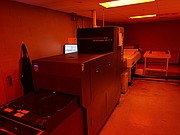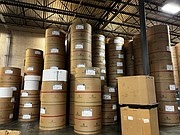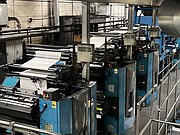The proof is in the printing
Maybe I’m an old soul, but to me there just isn’t anything like the feeling of a newspaper between my fingers.
The paper has to be held tight, but not so tight that the paper rips.
That sound of the paper snapping as you open it.
And who can forget the tiny bits of ink that make their way onto your fingertips.
There’s just something different about reading an actual newspaper.
In my lifetime, I have worked in several different aspects of the newspaper industry – as a carrier for the entire north side of Kellogg for about three years, a 6-month stint in advertising in 2011, and as a writer/editor for the past 7.5 years.
That tallies up to time spent in circulation, advertising, and editorial – but never production.
Quite literally, I had very little idea of how our newspapers are made – until November 17.
The production team over in Coeur d’Alene might be the unsung heroes of the entire operation – they work some of the oddest hours – across any field – in order to make sure that multiple different products are printed on time, distributed to their proper destinations, and that all look great.
The process is an incredible one – layered in multiple steps that require an entire team to pull off.
Each day a specific newspaper is printed a diagram of the newspaper is sent to each editor – these diagrams, called dummies, allow the editor to know the size of the newspaper that they are to fill. The dummies also allow them to see where advertisements are scheduled to be placed and what their exact size is. Each paper is roughly a 50/50 split on the total editorial content and total advertisement.
Once a story is written, a photo is taken, and all of this content is submitted to the layout team – the newspaper becomes a literal work of art.
The layout team, including the talented Hillary Main (who handles much of the primary layout for the Shoshone News-Press), places the stories digitally on a scaled version of the paper – making sure that all of the stories that are supposed to hit the front page are strategically placed and that there is enough room for those stories to make their individual jumps to the inside.
Once that layout is approved, it moves into the hands of the team at the production center.
The production building is across the street to the north of the Coeur d’Alene Press office – but don’t let their proximity to one another fool you. These are two very different worlds.
One building is a modern, yet industrial-looking building where the editorial, advertising, and circulation departments conduct their daily business – where the volume stays at a low hum (most of the time). The production building is a warehouse, where the moments of quiet are fewer, but somehow there is comfort in the constant noise generated from the multiple machines that are in operation.
This is where the news becomes a newspaper.
Once each section of the paginated properly, the pages are plated. A newspaper plate is a sheet of aluminum that contains the image of a newspaper page on it. Each page of the newspaper requires an individual aluminum plate.
For newspapers that print full-color pages, four plates are made per page – one for each of the four basic colors (cyan, magenta, yellow and black) that, combined, make up all the colors of the rainbow. The plates are then attached to giant drums on the press units, and the press is started.
The way those plates are arranged is important because, for each section that is printed, the first and last pages are on the same sheet of paper. For example, in an 8-page section, the plates for page 1 and page 8 would be next to each other, as well as pages 2 and 7, and so on.
This is really Dave Koller’s world – which he was kind enough to explain to us and even give us a few fun factoids (a couple might actually blow your mind).
Koller operates the press in Coeur d’Alene, and almost every newspaper that comes out of the building has been worked on by him in some capacity or another – which is really just the tip of the iceberg for what they do.
“There are five core products that run between two and six days a week,” Koller explained. “The CD'A/Post Falls Press, the Bonner County Daily Bee, Bonners Ferry Herald, Columbia Basin Herald, and the Shoshone News-Press are the staples of our work week. We have dozens of commercial products that print throughout the week on top of that though and those jobs vary a lot from week to week.”
The press machine utilized for the North Idaho newspapers is a Goss Magnum coldset offset 5 tower press with a Goss C-5 folder and six Megtec roll splicers.
At a top speed of 40,000 copies per hour, the press can print 18 pages of full color (including 16,000 different colors), and the press never has to stop for roll change if the current roll runs out.
Now, I want you to imagine that you’re holding a sheet of newspaper, can you picture it?
Pretty light, right?
It’s a stark contrast when you compare it to a full roll of newsprint.
Each full roll of newsprint weighs 1,200 pounds and can facilitate roughly 33,000 copies – the press uses between five and 10 full rolls per day depending on what newspapers are being printed.
The continuous roll of paper stretches 11 miles, enough to cover the distance between Kellogg and Wallace.
You have the press, you have the paper, but you also need ink. And the ink used by North Idaho newspapers is pretty cool.
As mentioned, four colors make up the 16,000 possible colors that can be printed – cyan, magenta, yellow and black. The ink we use is soybean-based and non-toxic – technically it’s edible although I wouldn’t recommend it.
The press works pretty fast too, the previously mentioned top speed of 40,000 copies per hour usually means that the printing process is a relatively quick one in the grand scheme of things.
“In total it takes about 25 to 30 minutes to run the Shoshone News-Press,” Koller said. “That includes setup (hanging plates, setting ink, setting the folder). Once the press is up to speed and we have started saving copies for production it only takes about five minutes to run. Setup time for most runs is always about the same but the run time for production copies varies quite a bit. With setup and runtime, the main section of the CD'A Press takes about an hour.”
Obviously, a paper with a smaller circulation takes less time to print than one with a large circulation base.
And when Koller says fast, he means it.
Like anything requiring ink, you have to move quickly so that the ink doesn’t dry up too soon.
And you can only make so much ink go so far.
Picture it like a giant rubber stamp – except that it moves a lot faster than your grandmother’s hands do during holiday card-making season.
Koller has been working around the press for over two decades and for him, the reward of seeing something become reality is one of the best aspects of his job.
“I think the coolest thing about printing the paper is that the press is where the intangible stuff we see on the computer screen turns into something physical,” Koller said. “Watching the blank white paper come alive with all the words and colorful images is still neat after almost 25 years of printing.”
Once the papers have been printed, all of the extra guts – things like classifieds, ads (like those you got last week for Black Friday), and special sections like the one you’re reading right now – get neatly inserted into the paper which gets bagged, sealed, and bundled.
From there, the papers get dispersed to the communities they serve – either by carrier, kiosk, or counter sales.
Maybe that special thing about reading an actual newspaper isn’t just the paper itself, maybe it’s the fact that dozens of people have put countless hours into creating that newspaper.
When you’re reading a newspaper loaded with content, including carefully crafted and informative stories, beautiful photography, all laid out to make sure they all fit, you don’t always realize the efforts of those people.
Hopefully, that changes after reading this.
Happy Holidays
Don’t forget to tip your carriers.







